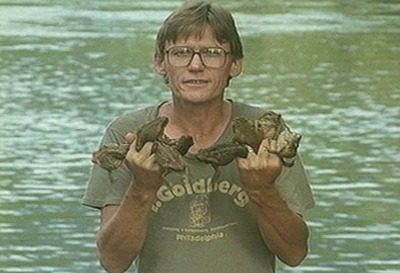Earlier this year, I wrote up Rat, Mark Lewis’s highly enjoyable documentary about the indomitable New York rat. Rat led me to Lewis’s first and best-known movie, the 1988 short feature Cane Toads: An Unnatural History, which is, if anything, even better. I say that as someone with a visceral revulsion towards toads. (I respect their right to thrive, I just prefer they do it far away from me and ideally out of my sight.) It’s especially impressive, then, that Cane Toads is a profoundly likable film even when I’m recoiling from its subject matter.
The cane toad, as the title of its Australian species-biopic implies, is not native to Australia: it was introduced there to feed on the beetles that were a major blight on the sugarcane crops. Instead, it fed on literally everything else. The cane beetles continued on unabated, and the cane toads bred in massive numbers, completely overwhelming the ecosystem. Anything its size or smaller became its prey, and its poison was fatal to nearly every native predator; gluttonous and often deadly even in death, the cane toad single-handedly winnowed down local animal populations across the board. Pets, naturally, are not immune. Consequently, and unsurprisingly, a lot of people really don’t like them.
But, just as unsurprisingly, a lot of people really do. If you don’t remember–or weren’t even alive–when the cane toad was first brought to Australia, it feels as native to you as anything else. Queensland residents like that the toads are “their” thing (though they’re slowly becoming all of Australia’s thing), and adopt them as mascots and put up statues of them. Little girls adopt them as cuddly living dolls. For late arrivals, they’ve left an outsized cultural footprint: the movie treats us to multiple songs on the subject, one of which is still playing on loop inside my head.
Cane Toads gives about equal focus to the people who view the toads as their neighbors, even leaving food out for them, and the people who go out of their way, for reasons both personal and ecological, to leave them as smears on the road. The first group undeniably seems calmer and more agreeable, on the surface; they’re certainly less bloodthirsty. But the second group has very good reason to believe that the cane toad is a plague, and I have to admit that my heart belongs to the scientist who forever loathes them because a native cat he loved died from their poison, which it never stood an evolutionary chance of being immune to. But Lewis’s heart probably lies with the cane toads themselves, in all their ugly, bumpy (and sometimes necrophiliac) glory. They didn’t ask to be brought to strange shores. It’s not their fault they’re thriving. And their poison only spurts out–we see the process, and it’s like a zit being popped–when they’re either in great distress or having their necks chewed on, so can we really blame them for self-defense? This colorful, breezy, empathetic documentary makes them perversely lovable, even to me, and it provides a good reminder that the cane toads are, again per the title, an unnatural problem. We could have left them where we found them. Their presence in Australia, and whatever damage they’ve done to the environment there, isn’t because they’re uniquely awful, it’s because of humanity’s Jurassic Park-like tendency to believe we’ve got the animal kingdom completely under control. But cane toads, uh, find a way.
Cane Toads: An Unnatural History is streaming on the Criterion Channel.


